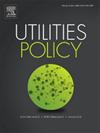Digital infrastructure investment and carbon emissions reduction based on the Broadband China policy
IF 4.4
3区 经济学
Q3 ENERGY & FUELS
引用次数: 0
Abstract
A multiphase difference-in-differences model is used to explore the impacts of digital infrastructure investment on carbon emissions based on the Broadband China (BC) policy. The benchmark analysis of pilot cities reveals that the BC policy is associated with carbon emissions reductions of approximately 0.05 %. The mechanistic analysis indicates that the BC strategy increases urban innovation capacity, motivates the public to live environmentally friendly lives, optimizes the industrial structure, and, as a result, reduces carbon emissions in cities. This study offers valuable reference data for resolving the dilemma of promoting emission reduction while maintaining economic growth to achieve the dual-carbon target.
基于宽带中国政策的数字基础设施投资与碳减排
基于宽带中国政策,采用多相差中差模型探讨了数字基础设施投资对碳排放的影响。试点城市的基准分析表明,BC政策与碳排放量减少约0.05%有关。机制分析表明,BC战略提高了城市创新能力,激发了公众的环保生活,优化了产业结构,从而降低了城市的碳排放。本研究为解决在保持经济增长的同时促进减排、实现双碳目标的困境提供了有价值的参考数据。
本文章由计算机程序翻译,如有差异,请以英文原文为准。
求助全文
约1分钟内获得全文
求助全文
来源期刊

Utilities Policy
ENERGY & FUELS-ENVIRONMENTAL SCIENCES
CiteScore
6.80
自引率
10.00%
发文量
94
审稿时长
66 days
期刊介绍:
Utilities Policy is deliberately international, interdisciplinary, and intersectoral. Articles address utility trends and issues in both developed and developing economies. Authors and reviewers come from various disciplines, including economics, political science, sociology, law, finance, accounting, management, and engineering. Areas of focus include the utility and network industries providing essential electricity, natural gas, water and wastewater, solid waste, communications, broadband, postal, and public transportation services.
Utilities Policy invites submissions that apply various quantitative and qualitative methods. Contributions are welcome from both established and emerging scholars as well as accomplished practitioners. Interdisciplinary, comparative, and applied works are encouraged. Submissions to the journal should have a clear focus on governance, performance, and/or analysis of public utilities with an aim toward informing the policymaking process and providing recommendations as appropriate. Relevant topics and issues include but are not limited to industry structures and ownership, market design and dynamics, economic development, resource planning, system modeling, accounting and finance, infrastructure investment, supply and demand efficiency, strategic management and productivity, network operations and integration, supply chains, adaptation and flexibility, service-quality standards, benchmarking and metrics, benefit-cost analysis, behavior and incentives, pricing and demand response, economic and environmental regulation, regulatory performance and impact, restructuring and deregulation, and policy institutions.
 求助内容:
求助内容: 应助结果提醒方式:
应助结果提醒方式:


